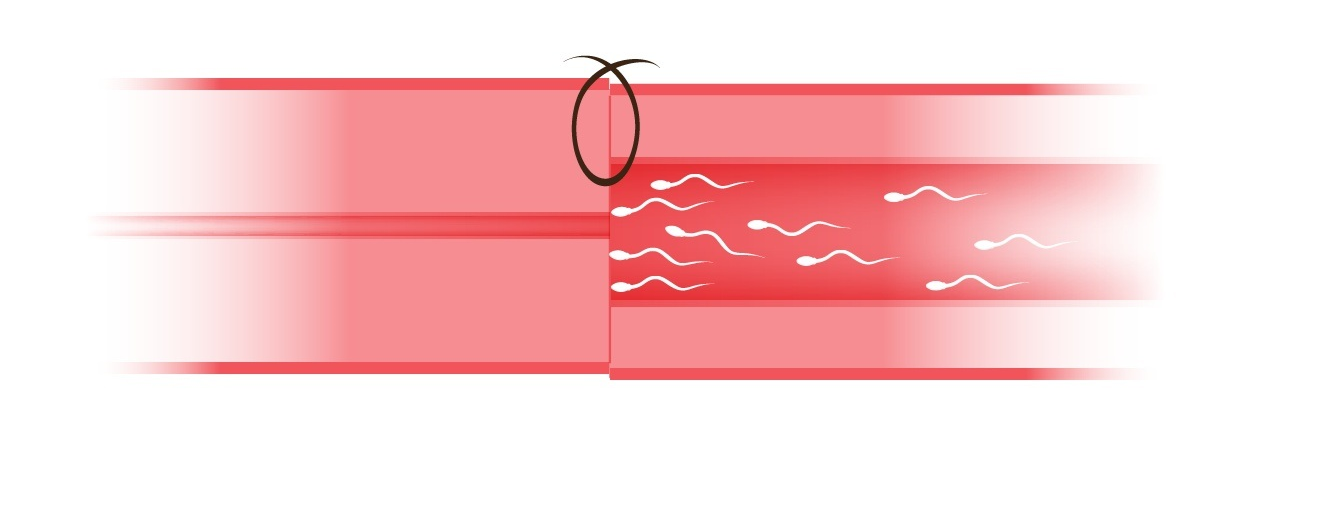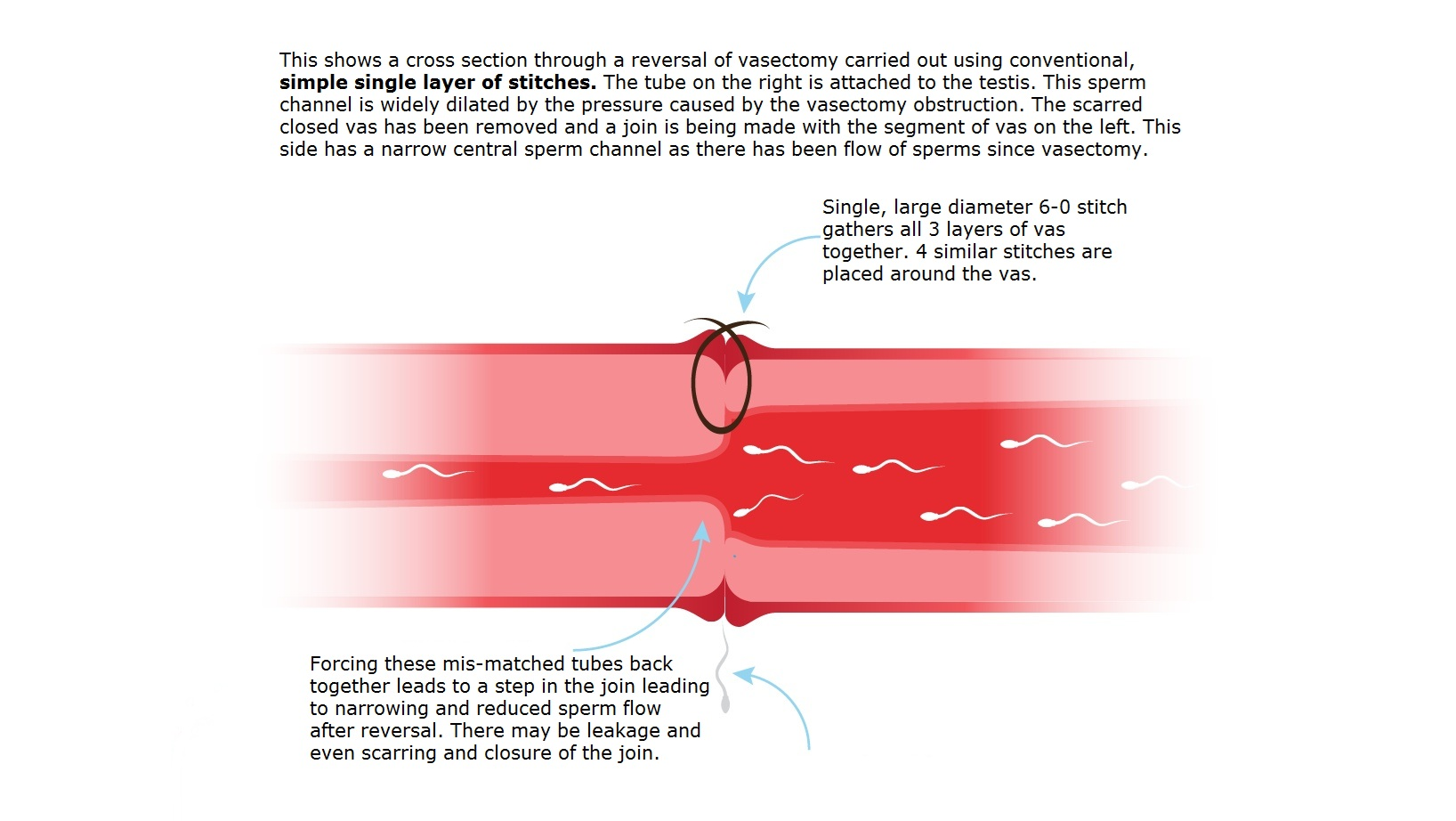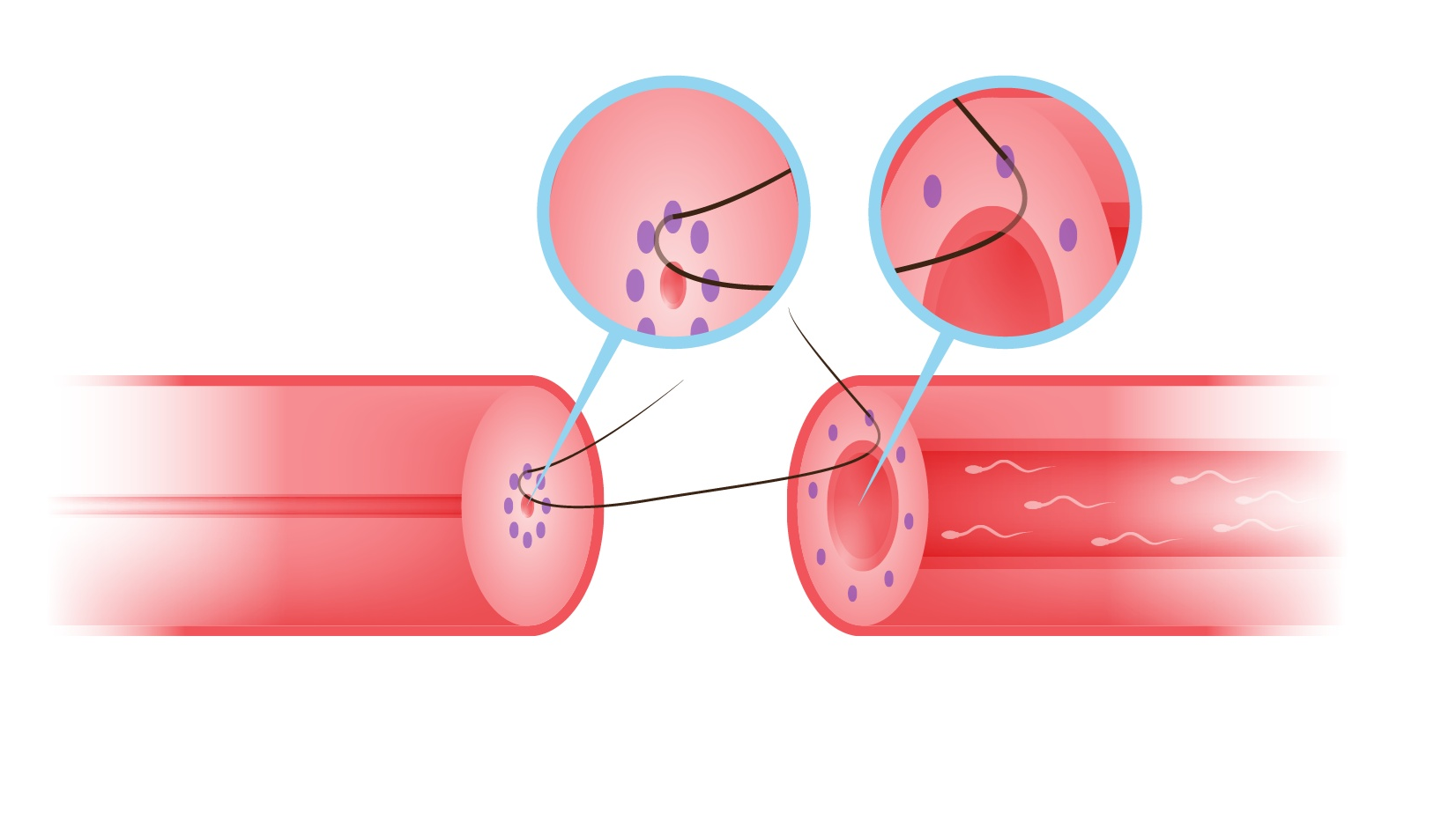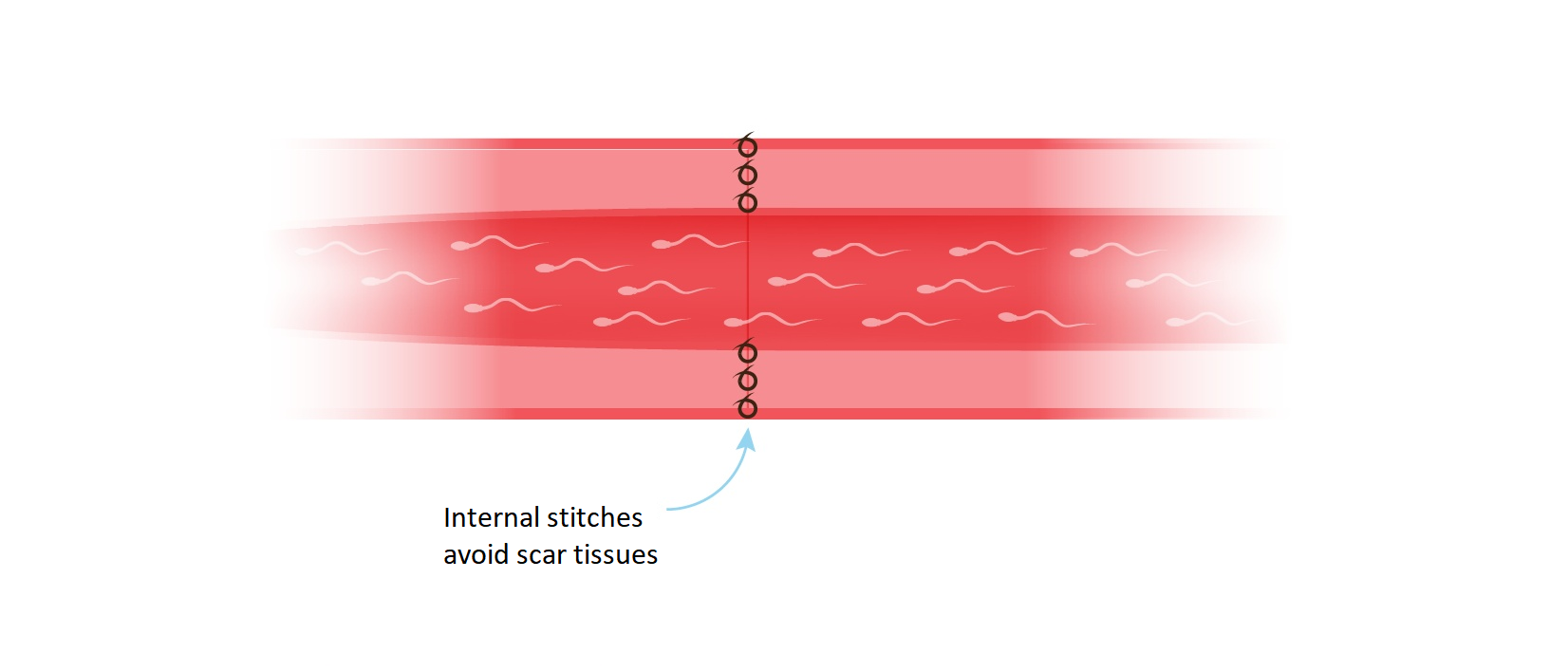Welcome to the Right Place for Facts about Vasectomy Reversal
If you are considering becoming a dad again after a previous vasectomy or a previously failed reversal, you are at the right place to learn all you need to know about vasectomy reversal. We believe the information on this page will benefit you in choosing the right clinic and surgeon for the reversal. The standard of the services provided is very variable in different clinics. If you have this information about the best possible standard, you can ask the questions and make a fully informed decision.
What is Vasectomy Reversal?
Vasectomy reversal (Snip Reversals or Reversal of Male Sterilisation) is the operation to identify the cut ends of the vas (which has a minute openings (lumen) diameter of 0.2mm - 0.4 mm) that carries sperms from the Testis to the penis and reconnect them to transport the sperms again.
The main principles of this operation include the following
- Achieve the best possible alignment of the minute openings (lumens) of both cut ends that could be of different diameters
- Connect them in a leakproof manner, as leakage of sperms can trigger inflammation and cause blockage of the connection
- Preserve the blood supply to the vas throughout the procedure, as careless handling may compromise the blood supply and cause scarring & blockage.
- If there is blockage upstream at the level of the epididymis, then a procedure of connecting the vas to the epididymis (Vasoepididymostomy) will be needed. A reversal service cannot be a complete service if the surgeon does not take steps to diagnose the blockage and perform this procedure. Simply connecting the vas end to the other end will not work.
If these principles are not adhered to, the operation will likely fail due to blockage at the connection.

Understanding Vasectomy Reversal: Key Insights & Facts
1. Debunking Myths about Vasectomy Reversal
Contrary to popular misconceptions, even among some healthcare professionals, vasectomy is often a reversible procedure with high success rates. Many couples, when exploring fertility options, first approach local fertility clinics. Regrettably, these clinics predominantly suggest IVF (In Vitro Fertilization) as the sole solution. They often overlook informing couples about vasectomy reversal, a procedure that can enable natural conception. While IVF has its merits, it involves invasive procedures for both partners. For many, vasectomy reversal could be a more natural and primary choice. However, in certain cases, IVF might be the better option, as discussed later.
2. Identifying Genuine Microsurgery Clinics
The success of a vasectomy reversal largely hinges on the quality of microsurgery performed. The multilayered reversal technique stands as the current gold standard. When considering a clinic, ensure you ask:
- The duration of the operation and the number of layers used in the connection. A thorough three-layer procedure typically takes about 3 hours.
- If they separately connect the inner (mucosal) layer, a crucial and intricate part of the operation.
- The type of stitches used. Ideally, they should use ultra-fine 10-0 or 9-0 stitches.
- The frequency of procedures the surgeon performs. A higher number, done correctly, often indicates better outcomes.
3. The Importance of Checking for Blockages
A crucial step in the reversal process is checking for blockages in the epididymis, which can occur due to pressure buildup post-vasectomy. If present, a more intricate procedure, Vaso-Epididymostomy, is required. The fluid examination is essential to:
- Determine the right procedure: vasovasostomy (vas to vas connection) or Vaso-Epididymostomy.
- Predict the outcome more precisely.
- Understand the cause of failure, if it occurs, and advise on potential redo-reversals.
4. Vasectomy Reversal Standards in the UK
Reversal techniques in the UK vary, and it's essential to understand the differences:
- Basic Reversal: Uses magnifying loupes and larger stitches. This method is outdated and less effective.
- Intermediate Reversal: Utilizes an operating microscope but still employs larger stitches. While better than the basic method, it's not the best standard.
- Advanced Multilayer Microsurgery: The gold standard. Uses an operating microscope and the finest stitches for precise multilayered connections.
5. Age and Time Since Vasectomy
Men continue to produce sperm throughout their lives, albeit with declining quality as they age. The duration since the vasectomy can influence the outcome, but it's not the sole determinant. Even if it's been over 20 years since the vasectomy, success rates with the right procedure can still be promising.
6. Vasectomy Reversal: A Step Towards Parenthood
While vasectomy reversal can restore fertility in men, it's not a guaranteed ticket to parenthood. The procedure addresses only the male aspect. Factors like sperm quality and potential fertility issues in the female partner can influence the chances of conception. It's essential to evaluate both partners' fertility health before deciding on the reversal.
7. Defining Success: Vasectomy Reversal vs. IVF
The success metrics for vasectomy reversal and IVF differ. For reversals, success is gauged by the patency rate, indicating sperm presence in the semen. However, the actual pregnancy rate might be lower due to various factors. In contrast, IVF success is measured by the pregnancy rate. Nonetheless, vasectomy reversal offers the chance for natural conception.
In conclusion, vasectomy reversal offers a promising avenue for couples wishing to conceive naturally. However, it's crucial to be well-informed, choose the right clinic, and consider all factors before making a decision.
Listen to the Surgeon for a comprehensive Overview of the Vasectomy Reversal Operation to Regain Fertility.

What do we offer at Best Life Clinic? Only the Current Best Standard
We offer the same advanced Microdot Multilayer Microsurgical Vasovasostomy (MMMV). This service is unique in the UK. We are cost-effective and maybe even cheaper than some clinics offering basic procedures. You can easily identify how long the operation takes and what size stitches the surgeons are using. Please do not hesitate to ask that question. We have not seen many surgeons in the UK fully transparent that they do this multilayered procedure though this is the standard of care in most male-infertility centres in the United States. This operation usually takes three hours using minute 10-0 and 9-0 sutures. The full magnification power of the operating microscope will have to be used during the difficult and minute steps of the procedure.
We also perform Vaso-Epididymostomy in the event of a Blow-out that is diagnosed during the operation. So there is hope even if there is a blowout. At the time of the procedure, we check multiple samples of the fluid from the testicular end of the vas. This ensures that our procedure has the highest possible chances of success.
Which Clinic should you choose?
Please do your research and read through the materials on our website. Based on that, it is up to you to make your informed choice. You may wish to choose a clinic close to you geographically, but ensure you get the best standard of care. The surgeons using basic techniques may claim that their techniques are working. Nature's healing mechanism is indeed so wonderful there is even a chance of a spontaneous natural reversal in one out of 2400 men undergoing vasectomy. So all procedures will work to some extent, but do you want to settle for something less than the current best standard? If the surgeon can do only one type of basic reversal procedure, the outcome is left to the chance of you being the right patient for that surgeon. But it should be the other way around. The surgeon should have the skills and resources to make the procedure right for you as per the needs arising during the operation. The needs can be very challenging such as loss or damage to a long segment of vas, extremely thin vas, varying diameters of the cut-ends of the vas, vas being cut very close to the epididymis and blowouts.
We can assure you that we are capable and resourced to deal with these Challenging situations because of our unique factors and resources mentioned below.
- Ability to offer Advanced Multilayer reversal
- Allocation of four operating hours per patient. We dedicate the full four-hour session for each patient. Maximum, we perform two operations per day. We have performed 650 multilayered reversals by the same surgeon.
- Resources & skills to do vaso-epidydimostomy at the same sitting
- The all-inclusive cost for the procedure (Click here for the information on Cost)
Practical Aspects of the Reversal Service at Best Life Clinic.
For more detailed information on the vasectomy Reversal journey with us, please visit our web page ' by clicking the link below.


The vast majority of our patients decide after a remote video consultation except those who desire to come for a face-to-face consultation or those who seek this operation for post-vasectomy pain or if we sense any high-risk factors in their clinical information provided. You will have the opportunity to discuss with the surgeon, Mr Manohar Jesuraj, the full details of the reversal specific to your situation, possible outcomes, risks and alternatives. Then you will receive a written summary of the consultation with some other information, including a web page link to available dates for the procedure over the coming months. There is no obligation for you to get back to us. We do not pursue patients after consultation unless they return and book the procedure. We aim to give you balanced information and help you decide. If you would like to benefit from this consultation, please complete a detailed questionnaire at this link. Consultation
Booking for the procedure
After receiving the consultation documents and information about the reversal, you may get back to us with your chosen date and pay the deposit to book a date for the procedure. Click for details of the Fee and Deposit.
Operation
Lasts approx. 1½ to 2 hours on each side.
- Usual Approach via a single horizontal or vertical incision
- We locate the vas and the site where the original vasectomy blocked the tube.
- Then we section the tube above and below this area to locate fresh open vas. At this stage, we check that the reproductive tract is still functioning by flushing the upper vas with saline and sampling fluid from the testicular vas under the microscope.
- Vasovasostomy ie. joining the ends of the vas together using special, very fine stitches thinner than a human eyelash (10.0 Nylon). The medical description of our operation is 'Multi-layer, Microdot Microsurgical Vasocasostomy'. In this exquisite procedure devised by Professor Goldstein, the inner layer of the vas that carries the sperms is microsurgically stitched together, followed by the muscle of the wall of the vas. Then the overlying tissue is closed over the top of the repair for strength and to ensure blood supply.
- In selected cases with definite signs of a blowout, we perform Vasoepididymostomy. This is an even more time-consuming and delicate procedure
Afterwards.
There are one of two scars, approx. 3 cm long - one on each side of the scrotum. We usually close these with a dissolving stitch buried under the skin so that there is no need for further visits to the Clinic. After taking tea and biscuits, the patient is accompanied home to rest.
On the night of the operation
We recommend that you stay the night in a local hotel if you live further than an hour's drive away. We can recommend the local hotels which are relatively less expensive.
Return to work.
You must rest completely for 3-5 days and then return to normal activities five to seven days after the operation. You should avoid strenuous work for three weeks and avoid contact sports or bicycling for 4-6 weeks.
How will I know if the operation was successful?
We recommend an initial semen test for 12 weeks post-operatively, by which time we would expect a return of small numbers of sperm to the semen. Return to full fertility can take up to 12 months (in some cases, up to 18 months). We request that your local GP arrange further tests at a nearby pathology lab. Your GP may decline to arrange this as an NHS patient. If that happens, we can request that you take it to a local fertility clinic and pay the appropriate fee to complete the test. Since most of our patients come from distant places in the UK and abroad, we have not included any cost of post-operative tests, including semen tests, in our fee.
We are pleased to offer our assistance in interpreting the test results and facilitating communication with your GP free of charge for a period of up to 12 months after the procedure. We are here to help and guide you every step of the way.
What are my chances of becoming fertile again?
This depends on many factors, but chiefly the length of time since your vasectomy was performed. This is because the likelihood of the tubes being blocked increases with each year; however, the operation is successful in more than 80 % of men who had the reversal within up to 10 years after vasectomy. Even if the vasectomy was done more than ten years ago, there is still a worthwhile chance of success. For full details on the expected outcome, please click Chance of Success.
Diagrammatic Illustration of Our Reversals Procedure
Reversal by Our Gold Standard Technique
Introduction – it is natural to think that a reversal is a reversal and that all operations are roughly the same, so it is OK to shop around for the cheapest. This presentation is to explain why we use the MMMV procedure, which takes about 3 to 4 hours to perform using expensive materials and gives the world’s best reversal results.
1. This is a diagram of the normal vas – a tiny (0.2 mm) sperm channel surrounded by a strong muscle coat and, beyond that, a layer of connective tissue, sinews and blood vessels. The overall diameter is around 2 mm.

2. Following vasectomy, which blocks the vas, there is high pressure on the lower testis side caused by the force of the sperms trying to escape. This causes the central sperm channel on the testis side to enlarge and dilate so that when we come to remove the vasectomy scar and rejoin the tube, the two ends of the vas look like this;

3. The simple method of reconnecting the tube is to stitch together the ends using a stitch that goes all the way through all three layers of the vas. This combines the very narrow end of the body side of the vas with the dilated testicle end of the vas, leaving a shelf where the two meet, as shown in the diagram. The technique is quick for the surgeon, who can often manage 6 or 8 daily operations. Surgeons doing this procedure usually use size 6-0 stitches with thicker needles. Such stitches can be handled by conventional instruments rather than real micro-surgical instruments. That will enable the surgeon to do the procedure quickly. ( Remember, less operating theatre time, more number of procedures, more profit for the surgeon and the hospital!!) In such procedures, the operating microscope works similarly to a magnifying loupe rather than being put to its full use.

4. The consequences of joining the vas in this way are as shown in this diagram, a narrow channel is formed for the sperms to swim through under pressure leading to low sperm counts, poor sperm quality (because they expend too much energy swimming through a narrow junction) and early scarring and closure of the join. This technique is used all across the UK and in clinics that perform reversals quickly with up to 6-8 patients in one day.

5. Professor Goldstein developed the Multi-layer microdot reversal (MMMV) at New York’s Cornell University to improve the pregnancy rates of reversals and make them as free from scarring as humanly possible. Results from Professor Goldstein’s trial of this method show that he has a 99.7% success rate with this technique and a pregnancy rate of well over 50%. Here is how it works. Of course, the dimensions of the vas are so small that special instruments have been developed for our use. First, six microscopic ink dots are placed on the ends of the vas to be joined, each at the same distance from the skin of the sperm channel. Next, a single micro stitch, a needle on each end, is placed through each of the six dots, and the stitch is tied together. This joins together the skin layer of the vas very accurately, opening up the narrow end of the vas and gently narrowing the wide testicular end resulting in a smooth, step-free join that is wide open, allowing the maximum number of high-quality sperms to pass through. Because there are no rough edges in the joint, it is rare for scar tissue and closure to form.

6. The next or second layer of stitches brings the thick muscular layer on the vas together in a leakproof join, and finally, a third layer of micro stitches joins the outer layers of tissue and blood vessels.

.jpg)










.jpg)


